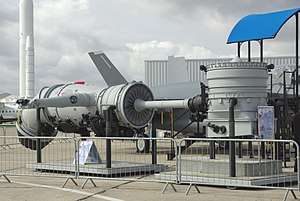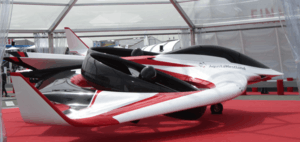Lift fan
Lift fan is an aircraft configuration in which lifting fans are located in large holes in an otherwise conventional fixed wing [1] or fuselage. It is used for V/STOL operation.

The aircraft takes off using the fans to provide lift, then transitions to fixed-wing lift in forward flight. Several experimental craft have been flown, but only the F-35 Lightning II entered into production.
History
A number of experimental aircraft were evaluated in the USA during the late 1950s and throughout much of the 1960s.
The Avro Canada Avrocar, commissioned by the USA, was intended to be a technology demonstrator for a supersonic VTOL aircraft. It featured a single central fan in a circular flying wing, with engine thrust directed rearwards for forward flight. It underwent trials between 1958 and 1961 but, due to its unstable "flying saucer" aerodynamics and lower than expected thrust, never flew out of ground effect. The Verticraft Verticar of 1961 was a similar single-fan, directed-thrust, all-wing (or lifting body) aircraft, of conventional but very low-aspect-ratio wing planform. It failed to fly. A tandem-fan version was proposed but never built.[2] By contrast the Ryan XV-5 Vertifan of 1964 was an otherwise conventional delta-wing jet. It had a large fan in each wing and a third, smaller fan in the nose to provide balance in pitch. It was more successful, with one of the two prototypes flying until 1971.
The Vanguard C2 and C2D Omniplane had two fans side by side, with one in each wing. It underwent tethered trials between 1959 and 1962 but never flew untethered. In the late 1960s NASA conducted wind tunnel experiments on a series of larger aircraft designs using different numbers of fans in the wings.[3]
Beginning with a one-sixth scale model in 1962, Paul Moller has been experimenting with the flying saucer configuration ever since. All have had a central cockpit but have varied between a single lift fan surrounding the cockpit, twin fans behind the cockpit or, more recently, eight individual fans distributed around it. Some examples such as the XM-2 of 1965 have been able to hover within ground effect. The artificially stabilised M200X was re-engined in 1989 and can fly out of ground effect, but has not entered production.[4]

Several projects were announced in 2010 and 2011. The Ray passenger aircraft had four fans arranged approximately in a square, similarly to a quadrotor, with a small fan in front of a larger one behind it in each wing.[5][6][7] The Lockheed Martin VARIOUS was a multi-role military UAV with twin fans side by side, one in each wing.[8][9] The Northrop MUVR ship-to-shore resupply aircraft similarly had a fan in each wing.[10] Unlike these the Anglo-Italian AgustaWestland Project Zero hybrid tiltrotor/lift-fan unmanned technology demonstrator was actually built and flew successfully in 2011. It has side by side twin fans which can rotate into a vertical plane to act as propellers in forward flight, while still located within the wing structure.
The F-35 Lightning II uses the Rolls-Royce LiftSystem, in which 29,000 hp[11][12][13] is diverted forward through a driveshaft from the engine's low-pressure (LP) turbine via a clutch[14] and bevel-gearbox to a vertically mounted, contra-rotating lift fan located forward of the main engine.
Israeli enterprise Urban Aeronautics is developing a wingless drone that uses a pair of lift fans to ensure lift by ground effect and another pair of fans for forward flight.[15]
List of lift fan aircraft
| Type | Country | Date | Role | Status | Description |
|---|---|---|---|---|---|
| AgustaWestland Project Zero | Italy/United Kingdom | 2011 | Experimental | Prototype | Twin tiltrotor/fans. Hybrid tiltrotor/fan-in-wing unmanned technology demonstrator. |
| Avro Canada VZ-9 Avrocar | Canada | 1958 | Experimental | Prototype | Single central fan in circular "flying saucer" wing. 2 examples flown. Trials 1958–61, never flew out of ground effect |
| Lockheed Martin F-35 Lightning II | USA | Fighter | In service | ||
| Lockheed Martin VARIOUS | USA | 2010 | Project | Twin fans. Multi-role UAV.[8][9] | |
| Moller M200X Volantor | USA | 1989 | Experimental | Prototype | Eight fans in circular "flying saucer" wing. |
| NASA wind tunnel test models | USA | 1967 | Transport | Project | Various designs.[3] |
| Northrop MUVR | USA | 2011 | Project | Twin fans. Ship-to-shore resupply aircraft.[10] | |
| Pegasus VBJ | South Aftica | 2019 | Business jet | Project | Lift fans in cranked dihedral wing, and rear thrust fans. One-eighth-scale model flown, prototype expected in 2020.[16] |
| Ray | 2010 | Project | Four unequal-size fans.[5][6][7] | ||
| Ryan XV-5 Vertifan | USA | 1964 | Experimental | Prototype | Three unequal-size fans. 2 examples built. One of these flew until 1971. |
| Urban Aeronautics AirMule | Israel | Experimental | Prototype | UAV | |
| Vanguard C2 and C2D Omniplane | 1959 | Experimental | Prototype | Twin fans. Tethered trials 1959–62. | |
| Verticraft Verticar | USA | 1961 | Experimental | Project | Single fan in flying wing/lifting body. Single prototype failed to fly.[2] |
References
- RayPosva, neuhaus, Wilhelm and Leyland. "Design and aerodynamic considerations about the civil VTOL aircraft" (PDF).CS1 maint: multiple names: authors list (link)
- Retro Mechanix (retrieved 11 March 2014 )
- IFO picture library - Moller's Skycars
- Ray Research
- On Fans and Wings - Switzerland's VTOL Ray, Aviation Week, 2010
- AeroRevue, "Ray" - new life for Vertical Takeoff Aircraft (English translation from German)
- Lockheed Martin: VARIOUS
- Lockheed VARIOUS UCAV concept
- Wraps Off Northrop's Fan-in-Wing MUVR, Aviation Week, 2011
- Warwick, Graham. "F-35B - The STOVL Challenges Archived 2014-04-13 at the Wayback Machine" Aviation Week & Space Technology, December 09, 2011. Accessed: April 10, 2014.
- Warwick, Graham. "F-35B - Lift Fan Archived 2014-04-13 at the Wayback Machine" Aviation Week & Space Technology, December 09, 2011. Accessed: April 10, 2014.
- Lockheed Propulsion System Archived 2010-06-20 at the Wayback Machine VTOL.org. Retrieved: 19 September 2010.
- Warwick, Graham. "F-35B - Clutch Archived 2014-04-13 at the Wayback Machine" Aviation Week & Space Technology, December 09, 2011. Accessed: April 10, 2014.
- "cormorant". Tactical Robotics LTD.
- Sarsfield, Kate (7 May 2019). "Pegasus prepares VTOL business jet for first outing". Flightglobal.com.
.